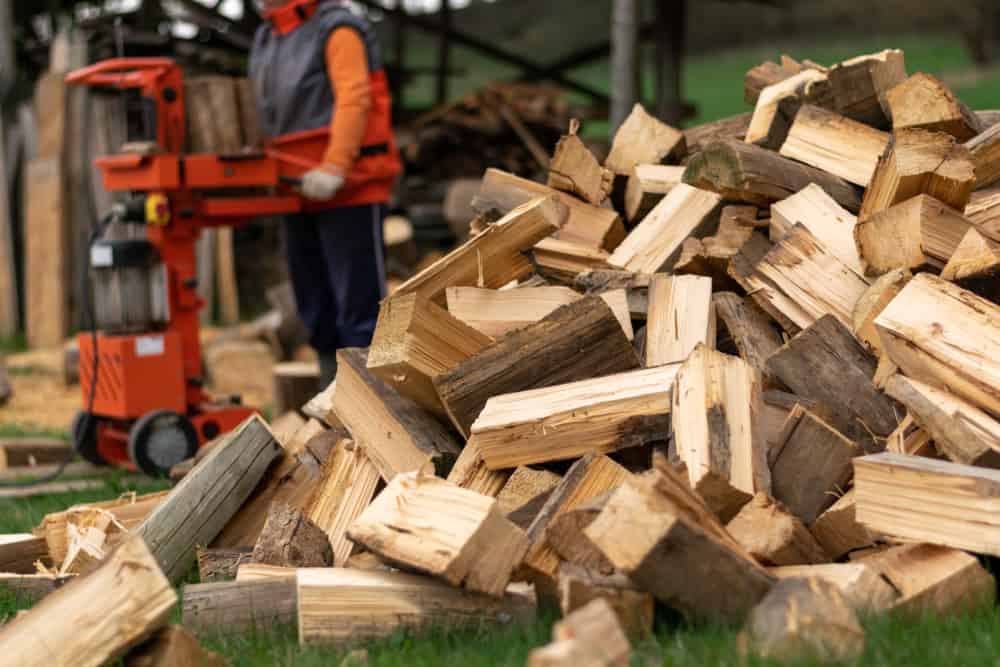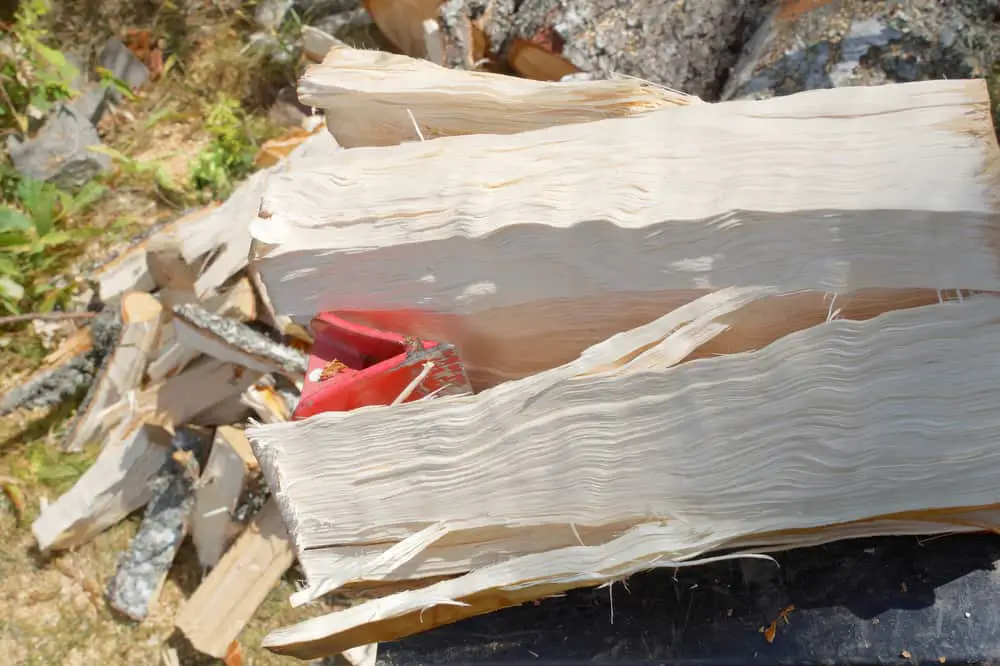Understanding the wood splitter is crucial for outdoor living.
Wood splitters are machines utilized for splitting different types of wood, including softwood and hardwood. They utilize either hydraulic or electric piston rods.
Splitting wood by hand can be difficult and tiresome, and when large quantities of wood need to be split, it can quickly become overwhelming.
While axes and saws can be useful tools for this job, more efficient and convenient methods are available.
Fortunately, tools like wood splitter make this necessary task much simpler.
Wood splitters are often rated based on the force they generate. A higher force means it can split larger wood.
Understanding the wood splitter is important even before purchasing one.
We will discuss the operation of wood splitters, the difference between manual and powered splitters, their composition, and most importantly, how to use them safely.

Table of Contents
Understanding the Wood Splitter Operation
Understanding how a wood splitter works is important before using one of the best ones available.
This information provides insight into the mechanisms of the machines and how to operate them.
There are two main types of wood splitters: powered and manual.
Powered wood splitters can be categorized as either horizontal or vertical.
These two types use different components, which will be discussed further below.
Powered Wood Splitters
If you’re looking for an efficient option, consider using a powered wood splitter.
They use either a hydraulic or electric piston rod to generate force.
Whichever device is used, it pushes the wood log towards or away from the blade, causing it to split.
It’s essentially an axe without the need for swinging.
With this tool, the log automatically slides through the blade without requiring additional effort from the user.
This not only saves time and energy but also allows for a larger amount of wood splitting to be done in a shorter period.
Wood splitters can be powered by electricity, gas, or a tractor.
These are just the very basics of understanding the wood splitter.
I have an article on the best log splitters for the money if you want to find something within your budget.
The most commonly used wood splitters are gas-powered as they don’t rely on a power source.
However, electric splitters are more environmentally friendly.
Powered wood splitters are divided into horizontal and vertical wood splitters.
Horizontal wood splitters are the most commonly used by homeowners because they are small and portable.
They can only process small logs due to their size.
People who make their log splitters face the same challenge.
I have a DIY article on making your own hydraulic log splitter, should you want to attempt this.
You could check out the article. However, I would recommend truly understanding the wood splitter and buying one.
Vertical wood splitters can handle any size of wood and are often used by professional tree removers.
They are larger and more expensive than horizontal ones.
Manual Wood Splitters
If you enjoy putting in extra effort and breaking a sweat to demonstrate your productivity, a manual wood splitter might be your ideal tool.
The design and functionality of manual wood splitters can differ based on the specific type you’re interested in acquiring.
Understanding the wood splitter is just as important for a manual model as gas or electric-powered.
A manual hydraulic wood splitter is a device that uses hydraulics to cut wood.
However, it is operated manually.
To operate the splitter, you need to move the handles back and forth, which will cause the piston to push the wood through a blade.
It’s like the electrical wood splitter, but you do all the work.
Understanding the Wood Splitter Components
A wood splitter is made up of various components. It’s important to understand the tools’ makeup before making a purchase.
Most wood splitters use a hydraulic system, which means they have all the typical features of such machines.
I have an article showing the simple machine of a wood splitter.
The components remain consistent regardless of the power source – electric motor, gas engine, or tractor.
The main hydraulic components of a log splitter are as follows:
- Hydraulic fluid tank
- Hydraulic cylinder
- Hydraulic pump
- Hydraulic control valve
- Power source
- Splitting blade
When purchasing this machine, inspect the hydraulic cylinder, pump, and power source.
These components determine the amount of force your wood splitter generates.
1. Hydraulic Fluid Tank
The hydraulic oil is stored in this part of the wood splitter.
When you use the wood splitter, the oil is pumped to the hydraulic pump, creating the necessary pressure.
A filter is typically installed to ensure that the oil stays clean.
2. Hydraulic Cylinder
The hydraulic cylinder is the chief support of any hydraulic wood splitter.
The wood splitter works by pushing the wood into the splitting head with the help of a cylinder, which then causes the wood to split.
To ensure the proper functioning of the wood splitter, it is important to make sure that the power generated by the hydraulic cylinder is not less than that generated by the hydraulic pump.
The cylinder may get damaged if that happens.
3. Hydraulic Pump
Using a two-stage pump to generate a flow of high-pressure oil that runs into the valve is common.
You need to ensure that the output power of the hydraulic pump matches that of the hydraulic cylinder for the desired effect.

4. Hydraulic Control Valve
It consists of a lever that allows you to operate the wood splitter.
It should be placed where you can easily access and safely operate it.
5. Power Source
Electricity, a gas engine, or a tractor can power the wood splitter.
The basic principles remain the same no matter which power source is being applied.
I have written this article comparing gas-powered with electric-powered log splitters.
6. Splitting Blade
There are three types of splitting wedges: two-way, four-way, and six-way.
Each wedge is designed to split wood into a specific number of pieces.
Understanding the Wood Splitter and Its Safety
When operating machinery such as wood splitters, it’s crucial to prioritize safety measures to prevent serious injuries.
You should be aware of the dangers associated with improper handling of the product you intend to purchase.
One hospital recorded 131 hand injuries in six years to emphasize the danger of wood splitters.
I have this guide on how to split logs for more information and one on log splitter safety. I hope they help you!
Safety Tips
- First things first, make sure you read the owner’s manual before you start operating the machine. Follow the instructions in the letter.
- Wear protective clothing like work gloves, metal padded work shoes, safety glasses, and ear protection.
- The only person operating the log splitter should be you. 21% of patients injured with wedge splitters stated that having someone operating the machine with them was a cause of the accident. Also, please keep children away from the machine!
- Keep your hands away from the ends when setting the log on the machine. Also, keep your hands away from the log while the wood splitter is on.
- Pay attention to the wood and the wood splitter at all times. Make sure there are zero distractions around you.
- Turn off the wood splitter if you ever need to reset the wood log into a proper position. That way, you will avoid any sudden accidents.
- Do not use the wood splitter when intoxicated, like other potentially dangerous equipment.
Projects Using a Wood Splitter
Wood splitters have various uses depending on the intended project.
If you’re looking to split wood for your fireplace or wood-burning stove, consider getting a domestic electrical or gas engine wood splitter.

Electric wood splitters are commonly used for indoor domestic use since there is a need for you to connect them to a power outlet.
The gas engine wood splitter cannot be used indoors because of the dangerous gasses they emit. It is best used for domestic outdoor projects.
The tractor-powered wood splitters are mainly used for farm, commercial forest and firewood projects.
You should only look to buy these if you own a farm or partake in any commercial activities that involve splitting wood.
You should always look at the tonnage force a wood splitter generates when purchasing to see if it meets your needs.
Most wood splitters are meant for domestic use.
Homeowners often use domestic log splitters with a force of around 10 tons to split wood for fireplaces or wood-burning stoves.
People with technical and mechanical knowledge can build their own log splitter.
Professional models are capable of exerting forces of 30 tons or more.
These models are typically used for professional forestry clearing or waste disposal projects.
Final Thoughts
Wood splitters are machines that make cutting wood easier, faster, and more efficient than using an axe or saw.
Depending on the job you need them for, they come in various shapes and sizes.
I wrote this other article to help determine the perfect size log splitter.
It’s important to always take proper safety measures when using machines as they can be dangerous and cause serious injuries.
Let’s make sure to stay safe!
Enjoy living the outdoor life!!!
